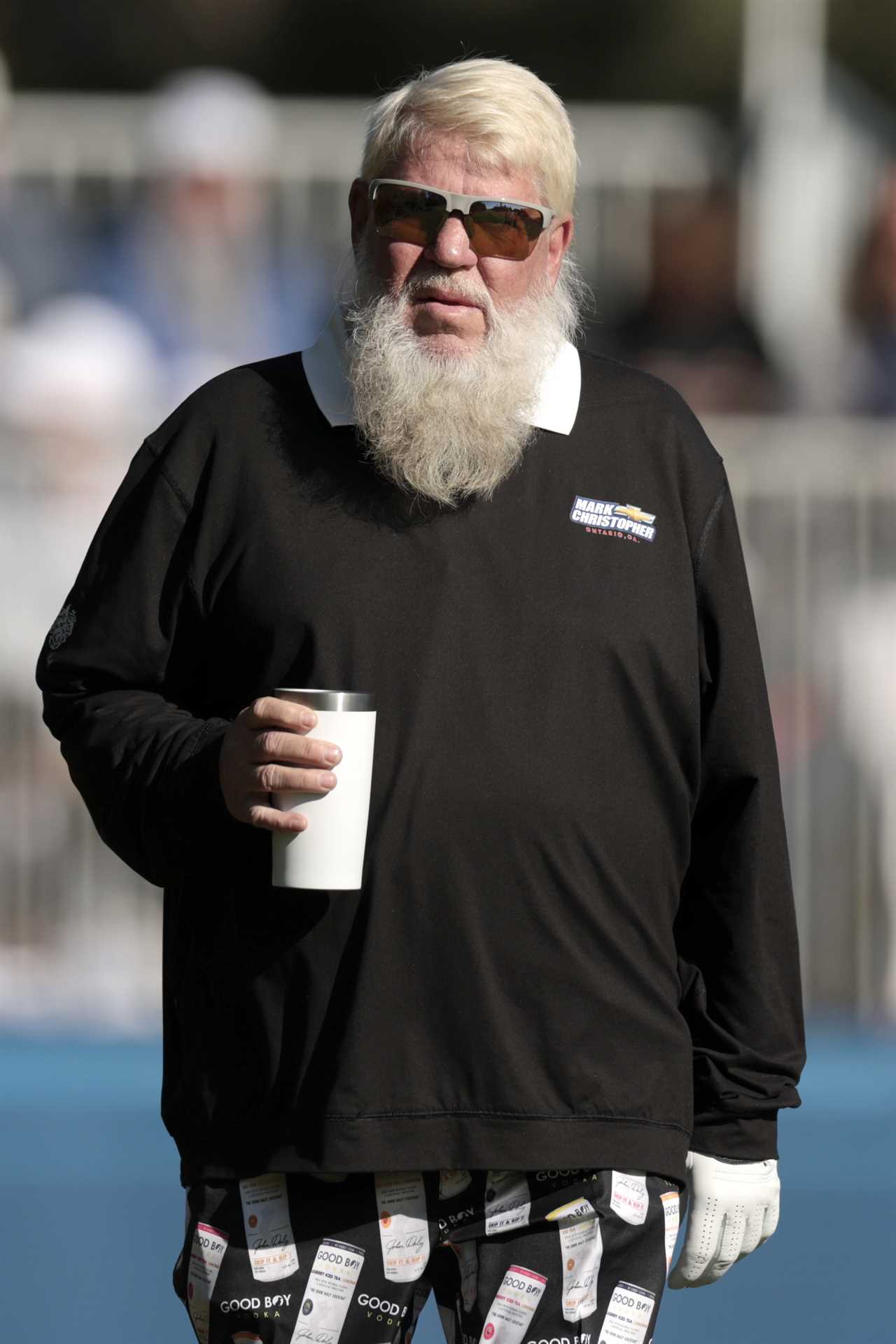
Back on the Greens After Major Health Setback
John Daly has silenced his critics and fans alike by making a swift return to the golf course following his latest health emergency.
A Tough Year: Multiple Surgeries and Recovery
The seasoned 58-year-old golfer underwent an emergency surgery on his hand in January, sparking concern among his dedicated followers.
Resilient Comeback at the Hoag Classic
Just two months post-surgery, Daly showcased his determination by competing at the Hoag Classic in California. His performance saw him finishing tied for 64th with scores of 74, 72, and 71.
Remarkable Recovery: “I’m Like Lazarus”
Reflecting on his journey, Daly humorously remarked, “I’m like Lazarus, I just keep coming back from the dead,” highlighting his resilience and unwavering spirit.

Enduring a Series of Health Challenges
Over the past four years, Daly has faced 16 surgeries, a testament to his enduring passion for the sport despite numerous setbacks.
Insight into the Surgery and Healing Process
Daly shared details about his recent operation, explaining, “The tendons were all wrapped around each other. The doctor doesn’t understand how I played last year. But he put it back, attached it to the forefinger or something."
Life on and off the Course: The Wild Side of John Daly
Known for his distinctive style and charismatic presence, Daly is often seen with a cigarette in hand and sporting vibrant outfits that make him a standout personality in the golfing world.
A Glimpse into Daly’s Memorable Moments
Nicknamed "Wild Thing," Daly secured victories at the PGA Championship in 1991 and The Open in 1995. His career peaked with a World No. 23 ranking in 2005, cementing his legacy as a beloved and eccentric figure in golf.

Unforgettable Anecdote: The $27,000 Night Out
During an appearance on the Full Send Podcast, Daly recounted an amusing incident where a fan unexpectedly covered his hefty strip club bill after he missed the cut at The Masters.
An Unexpected Act of Kindness
Daly narrated, “I had a girlfriend, Shanae, she was beautiful, I loved her. And she goes, ‘I’m gonna take you to the t***y bar’. We went straight to the dungeon downtown, Augusta.”
The Generous Stranger
He continued, “When I paid my tab of $27,000 there was a drunk sitting behind me yelling, ‘John how you doing man? I got your tab, don’t worry about it!’ I said, ‘You do NOT want this tab dude, no way!’ and he said, ‘let me see it.’ He saw it was for $27,000 and he looked back and said, ‘I got you.’”
Balancing Life’s Highs and Lows
Daly’s openness about his struggles and triumphs provides a raw and honest look into the life of a champion who has faced more than his fair share of challenges, both on and off the course.

Looking Ahead: What’s Next for Daly?
As Daly continues to recover and compete, his story serves as an inspiration to many, demonstrating that with determination and a touch of his signature humor, overcoming adversity is possible.
Legacy of a Golf Maverick
John Daly’s journey is a powerful reminder of the resilience required to stay at the top of one’s game. His ability to bounce back time and again makes him a true icon in the world of golf.
Frequently Asked Questions
What do I need to know about the maintenance of golf courses and their impact on game play?
Golf course care includes a number of different activities. From mowing the grass and watering it to aeration and topping off, there are many options. The way a golf course is maintained has a significant impact on play. The aeration of greens is a good example. Freshly aerated grass may be slower, but also less smooth. Fairways that have been heavily irrigated may play longer, but softer. Tighter mowing patterns can make greens faster. Being aware of maintenance schedules can inform your strategy on the course. Always check local rules or notices for information on any temporary changes to the course due to maintenance.
How often should I play golf to improve my game?
Improvement in golf comes with consistency and the quality of practice, rather than just the quantity. If you are a beginner, two to three sessions a week of practice can yield noticeable results. Spend time on all aspects of your game: long shots and short game as well as putting. Quality practice means having a clear aim for each practice session, such as working on swing technique, shot accuracy, or distance control. When possible, incorporate professional instruction to make sure your practice is efficient and does not reinforce poor techniques. Remember that it's more than just hitting as many balls you can; each shot counts.
How do I choose the correct golf club to make a certain shot?
The club you choose depends on the distance, the wind conditions, your ability level and any hazards. Woods are typically used for longer shots, whether you're playing from the tee box or fairway. Irons become more important as you approach the green. The lower-numbered (like a 4) and higher-numbered (like a 9) irons will be used for your longer approach shots. A pitching or sand wedge is often chosen for precision shots near the green, and, of course, a putter is used for putting on the green. Understanding how to choose the right club is greatly helped by estimating the distance between you and the target.
How can my golf swing be improved?
To improve your golf swing, you need to practice good technique and receive professional instruction. Start by establishing a good stance, grip and posture. It's important to keep your feet shoulder-width, hold the club with a grip that is neither too tight, nor too loose, and maintain an upright posture for a fluid movement. Slow-motion practice is a great way to learn the elements of your swing path, the alignment of the clubface, and the point contact. You can work with a coach for personalized feedback and refine your technique by driving or practicing on the range. Consistency, not power, is the key.
What is the correct golf etiquette when playing on the course.
The rules of golf are important but understanding golf etiquette can be just as crucial. Recognizing the pace of game play means being ready for your shot at your turn, and walking quickly in between shots. You should always show respect to the other players. Remain silent and calm when someone else is about to hit. Safety is equally important. Do not take a shot unless the group ahead has moved out of range. Repair divots and rake bunkers. Fix ball marks on greens. Additionally, it is polite to dress appropriately according to the dress code of the course you are playing.
Can I play golf on my own or do I need a partner?
You can play golf solo. Many people enjoy the personal challenge and peace that comes with playing alone. Solo play helps you concentrate on your golf without distractions, and is an excellent way to practice. Golf is a very social sport and playing with others enhances the experience. There's competition, camaraderie as well the chance to pick up new skills. Golf courses usually allow single-player play, particularly at less busy times. But some golf courses may pair players together with groups to optimize the course's usage during peak hours.
Why is it important to have a pre-shot routine in golf?
A pre-shot regimen can improve performance by establishing consistency and focus. This ritual includes identifying the golf target, visualizing ball flight, rehearsing swings, aligning body to target. A consistent routine can improve mental preparation by providing a familiar process to fall back on, especially under pressure. It helps manage nerves, minimize distractions and allows the golfer focus solely on the shot. It's important to find a routine you can repeat and is flexible enough to adjust to different shots.
Statistics
- Golfers who use a golf-specific fitness program can increase their drive distance by an average of 15 yards, benefitting their overall game.
- Approximately 2.2 million people took up the game of golf in 2020, reflecting a significant increase in interest among beginners.
- Over 35% of new golfers express the desire to play more rounds after experiencing their first full 18-hole game.
- Studies show that practicing putting for at least 15 minutes before a round can improve a player's putting accuracy by as much as 25%.
- About 85% of golf instructors recommend that new players focus on short game skills as an effective way to reduce their scores.
- Beginner golfers who invest in at least five professional lessons reduce their handicap by an average of 30% faster than those who do not seek instruction.
- Players with a consistent pre-shot routine are 50% less likely to make a mistake due to external distractions.
External Links
How To
How to Keep score in Golf
Knowing the basics is all you need to keep score. Each stroke is worth a point. Be sure to count every swing of the club, including any missed balls, or penalties incurred. On the scorecard, record the number of strokes you took for each hole. Also check the local rules for the course. Add up the scores of each hole after the round to get your total score. When playing with a handicap, adjust your score according to the course rating and your handicap index to see your net score.
 CricketBoxingFormula 1GolfHorse RacingPremier LeagueTennisPrivacy PolicyTerms And Conditions
CricketBoxingFormula 1GolfHorse RacingPremier LeagueTennisPrivacy PolicyTerms And Conditions
